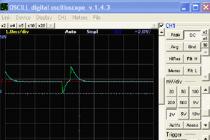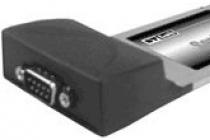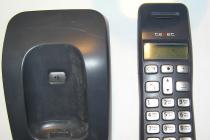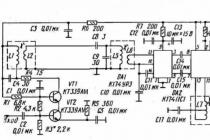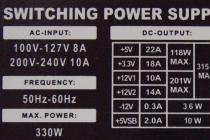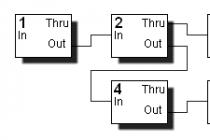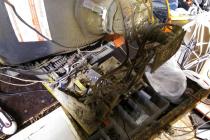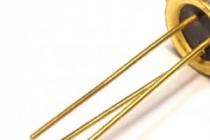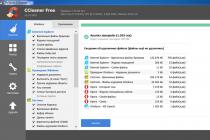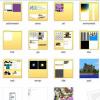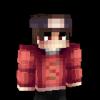What is MIDI?
Musical Instrument Digital Interface - digital interface of musical instruments. It was created in 1982 by the leading manufacturers of electronic musical instruments - Yamaha, Roland, Korg, E-mu, etc. It was originally intended to replace the control of musical instruments adopted at that time using analog signals, control using information messages transmitted via a digital interface. Subsequently, it became the de facto standard in the field of electronic musical instruments and computer synthesis modules.
MIDI is a so-called event-driven communication protocol between instruments. Whenever the performer makes any impact on the controls (pressing / releasing the keys, pedals, changing the positions of the controls, etc.), the instrument generates the corresponding MIDI message, which is immediately sent over the interface. Other instruments, receiving messages , work them out in the same way as when acting on their own controls.Thus, the stream of MIDI messages is like a cast from the actions of the performer, while maintaining his inherent style of performance - dynamics, techniques, etc. When recording on MIDI messages are timestamped to form a way to represent the score, and when played back, the original MIDI stream is fully and unambiguously restored.
The MIDI specification consists of the hardware specification of the interface itself and the specification of the data format - a description of the system of transmitted messages. Accordingly, the hardware MIDI interface and the MIDI data format (the so-called MIDI score) differ; the interface is used to physically connect the source and receiver of messages, the data format is used to create, store and transmit MIDI messages. At present, these concepts have become independent and are usually used separately from each other - data of any other format can be transmitted via the MIDI interface, and the MIDI format can only be used to process scores, without output to the synthesis device.
MIDI hardware specification
Interface - start-stop serial "current loop" (active transmitter, 5 mA, current sending - 0, currentless - 1), transmission rate 31250 ±1% bps and protocol 8-N-1 (one start bit, 8 bits data, one stop bit, no parity). Transmitters and receivers must provide rise times of less than 2 µs.Each instrument has three connectors: In (input), Out (output) and Thru (copy signal from In via buffer). All connectors - type female DIN-5 (SG-5), view from the outside (connection side):
Contacts 4 and 5 - signal, contact 2 - shield. The polarity of the signals is given relative to the current source: pin 4 is positive (current flows out of the output), pin 5 is negative (current flows into the output). Thus, for the Out and Thru connectors, the assignment is the same, for the In connector it is the opposite. The connection uses a two-core shielded cable up to 50 feet (about 15 m) long. The screen is necessary only for protection against radiated interference - the cable is practically insensitive to interference from the outside. The connection of the connectors on the two ends of the cable is straight (2-2, 4-4, 5-5).
One MIDI transmitter can connect up to four receivers.
The described scheme allows you to create a network of MIDI devices by connecting them in a chain and in several directions:
In this scheme, device 1 serves as a source of messages that device 2 receives and, through its repeater, device 3. Device 4 receives messages sent by device 2 (they may or may not include those received by device 2 itself) and relays them to the input of the device 5.
MIDI data format specification
MIDI data is messages, or events, each of which is a command for a musical instrument. The standard provides for 16 independent and equal logical channels, each of which has its own modes of operation; originally it was intended for single-timbre instruments capable of reproducing the sound of only one timbre at a time - each instrument was assigned its own channel number, which made it possible to perform multi-timbre performance. With the advent of multi-timbral (multi-timbral) instruments, they began to support several channels (modern instruments support all 16 channels and may have more than one MIDI interface), so now each channel is usually assigned its own timbre, traditionally called an instrument, although a combination of several timbres is possible in one channel. Channel 10 is traditionally used for percussion instruments - different notes in it correspond to different percussion sounds of a fixed pitch; the rest of the channels are used for melodic instruments, when different notes, as usual, correspond to different pitches of the same instrument.
Because MIDI messages are a real-time stream of data, their encoding is designed to facilitate synchronization in the event of a loss of connection. To do this, the first byte of each message, also called the status byte (status byte), contains "1" in the most significant bit, and all other bytes contain "0" in it and are called data bytes (data bytes). If, after receiving all the data bytes of the last message, the receiver input receives a byte that does not contain "1" in the high order, this is interpreted as a repetition of the information part of the message (the same first byte is assumed). This transfer method is called "Running Status" and is widely used to reduce the amount of data transferred - for example, one byte of the "Controller Change" command with the desired channel number is transmitted, and then a series of data bytes with the numbers and values of the controllers for this channel.
MIDI messages are divided into channel - related to a specific channel, and system - related to the system as a whole. MIDI message encoding (hexadecimal, n in the first byte indicates the channel number):
Channel messages:
- 8n nn vv- Note Off (note off)
- 9n nn vv- Note On (turn on the note)
- An nn pp- Key Pressure (Polyphonic Aftertouch)
- bn cc vv- Control Change (controller value change)
- Cn pp- Program Change (program change (timbre, instrument))
- Dn pp- Channel Pressure (Channel Aftertouch, channel pressure)
- En ll mm- Pitch Bend Change (change the value of Pitch Bend)
System messages:
- F0- System Exclusive (SysEx, system exclusive message)
- F1- reserve
- F2 ll mm- Song Position Pointer (position indicator in the score)
- F3 ss- Song Select (score selection)
- F4- reserve
- F5- reserve
- F6- Tune Request (tuning request)
- F7- EOX (End Of SysEx)
- F8- Timing Clock (time synchronization)
- F9- reserve
- FA- Start (starting the game according to the score)
- Facebook- Continue (continuation of the game according to the score)
- FC- Stop (stop playing by score)
- FD- reserve
- F.E.- Active Sensing (checking MIDI network connections)
- FF- System Reset (reset all network devices)
On the basis of MIDI, the GM (General MIDI - single MIDI) standard was later developed, which establishes the conditions for the mandatory compatibility of instruments and the interpretation of program and controller numbers, and then other standards (GS, XG) that expand GM. However, the commonality of instruments within each standard implies only basic sonic characteristics. "Same" timbres on different instruments almost always have different coloration, dynamics, brightness, default volume and other features, while "synthetic" timbres can be completely different from each other. In addition, different instruments differ in the dependence of the sound character on the strength of the strike on the key, the dynamics of the MIDI controllers, the default positions of the controllers, and other "fine" parameters. Therefore, a MIDI score prepared for a particular instrument often sounds completely different on other instruments (even within the standard), and this must be taken into account when transferring scores from between instruments of different models.
Instruments that support the GM and GS standards almost always have additional synthesis and sound processing controls that extend the scope of the standard. In this case, the control methods used are usually stored within the same line of tools and within the tools of the same manufacturer.
Description of the controllers
Bank Select Controllers
Many devices can work with a large number of built-in and additional timbres (instruments) and sound effects, which are combined into banks for convenience. Only one bank can be used in one channel at a time; controllers are used to switch banks:
- 0 - Bank Select MSB (bank select, high byte)
- 32 - Bank Select LSB (bank select, low byte)
Some devices require only one of these controllers to switch banks, others require both. The behavior of some devices in this regard may vary in different modes of operation.
Bank zero is set by default. After changing the bank, it is obligatory to send a Program Change message to select a timbre (instrument).
It may take a long time (tens of milliseconds or more) for the device to process a bank and instrument change command. Some devices, when receiving commands to change banks and instruments, damp sounding notes in the channel.
Modulation controller
Specifies the depth of frequency modulation in the channel. Management is absolute. A value of 0 disables modulation, a value of 127 sets the maximum depth. The default value is 0. Affects subsequent and already sounding notes.
Controller Portamento Time
Specifies the time to slide smoothly from the frequency of the previous note to the frequency of the next note. Management is absolute. The value 0 corresponds to the minimum time, 127 - to the maximum. The standard value is not defined.
Main volume controller
Sets the sound volume within the channel. Management is absolute. The default value is usually 100. Affects subsequent and already sounded notes.
Pan controller
Sets the stereo channel level ratio (stereo point) for the channel. Management is absolute. The value 0 is the leftmost position, 64 is the middle position, 127 is the rightmost position. The default value is 64. Affects subsequent and already sounding notes.
Expression Controller
Specifies the expressiveness of the sound. Management is absolute. On simple instruments, it duplicates the Main Volume controller and affects both subsequent and already sounding notes. On instruments with advanced synthesis, controls finer expressiveness parameters, and only affects subsequent notes. The default value is usually 127.
Harmonic Content Controller
Sets the quality factor (depth of resonance) of the channel filter, which allows you to emphasize the high-frequency harmonics of the timbre. Increasing the Q factor increases the filter's slope in the cutoff region, boosting frequencies immediately below the cutoff frequency. Relative control (0..64..127). The default value is 64.
Release Time Controller
Sets the decay time for the sound of notes from the moment the Note Off (explicit or automatic) is processed until the sound disappears completely. Relative control (0..64..127). The default value is 64.
Attack Time Controller
Sets the time of the initial attack - the increase in the volume of the sound of notes from the moment the Note On is processed to the maximum volume value. Relative control (0..64..127). The default value is 64.
Brightness Controller
Sets the channel's filter cutoff frequency, which controls the attenuation of high frequencies in the audio. Relative control (0..64..127). The default value is 64.
Controller Portamento Control
Specifies the note number from which the frequency is faded in Portamento mode, and allows you to set the initial pitch to something other than the one specified by the last Note On message.
Reverb Level Controller
Sets the depth of the selected reverb type effect (based on a constant signal delay) - Room, Hall, Delay, Echo, etc. Control - absolute or relative depending on the tool.
Chorus Level Controller
Sets the depth of a chorus type (based on a variable signal delay) effect - Chorus, Flanger, Phaser, etc. Control - absolute or relative depending on the tool.
Variation Level Controller
Sets the depth of the effect selected as Variation. Control - absolute or relative depending on the tool.
Sustain Switch Controller
When on, causes the sound to be sustained for all keys released while the controller is being actuated - similar to the right pedal of a piano. In other words, in Sustain mode, the channel delays the processing of the last Note Off message received for each note. At the time of shutdown, all Note Offs delayed in this way are processed simultaneously; the keys that are obviously held at this moment (for which the last received message is Note On) are not affected by disabling the mode.
Sostenuto Switch Controller
Functions like Sustain, but only sustains the notes that were pressed at the time the controller was turned on. Subsequent presses and releases are processed in the usual manner. In other words, the processing of Note Off is delayed only for those notes for which Note On was received before the mode was turned on.
Controller-switch Soft
Similar to the left pedal of a piano, causes the sound to be softened for the notes pressed while the mode is in effect. The method of implementation - a simple decrease in volume or more subtle control - is determined by the instrument.
Portamento switch controller
When disabled, each note you press will sound at a frequency determined by the pitch of the note and the currently set pitch controls (Pitch Bend Change and Coarse/Fine Tune, etc.). When the mode is on, the next note starts sounding at the frequency determined by the last Note On message or the Portamento Control controller, then its pitch smoothly changes to the desired one at the speed determined by the Portamento Time controller. Regardless of whether the slide was completed or aborted by a note release, the last Note On message is always fixed as the original pitch for subsequent notes. This means that if, for example, after the note C2, the note C7 was pressed, and then the note C4, then the pitch of the second note will gradually increase from C2 to C7, and the pitch of the third at the same time will decrease from C7 to 50, and in note 50 will be taken as the starting point for subsequent notes. At the moment C7 is pressed, this note will sound in unison with C2 and begin to slide towards C7, and at the moment C4 is pressed, it will sound at C7 and begin to slide towards C4. All slides are performed independently.
RPN, NRPN and Data Entry Controllers
Additionally, for advanced synthesis control, registered (Registered Parameter Number - RPN) and unregistered (Non-Registered Parameter Number - NRPN) parameter numbers are introduced, transmitted using controllers:
- 98 - NRPN LSB (NRPN low byte)
- 99 - NRPN MSB (NRPN High Byte)
- 100 - RPN LSB (RPN low byte)
- 101 - RPN MSB (RPN high byte)
The device remembers the RPN or NRPN once transmitted to it, after which the values of the selected parameter can be transmitted using controllers:
- 6 - Data Entry MSB (data entry, high byte)
- 38 - Data Entry LSB (data entry, low byte)
- 96 - RPN Increment (increase RPN by 1, value is ignored)
- 97 - RPN Decrement (RPN decrease by 1, value is ignored)
Thus, the mechanism is a "controller within a controller". The General MIDI standard defines the interpretation of only three RPNs, the values of which are given by the high bytes of the Data Entry parameters:
- RPN 0- Pitch Bend Sensitivity (Pitch Bend sensitivity)
- RPN 1- Fine Tuning (fine tuning)
- RPN 2- Coarse Tuning (coarse tuning)
The Pitch Bend Sensitivity determines the number of semitones that the pitch shifts when a Pitch Bend Change message is received with the parameter's high or low limit value. The default range is two semitones in either direction.
RPN tunings allow you to shift the instrument's pitch in the channel by a specified number of semitones for coarse tuning, or cents (hundredths of a semitone) for fine tuning. The value 64 is taken as relative zero.
The interpretation of the remaining parameters is not defined by the GM standard. In a number of instruments, two additional RPNs are also used to separately adjust individual instruments in different banks:
- RPN 3- Tuning Program Select
- RPN 4- Tuning Bank Select
The GS standard introduced a set of NRPNs to control envelope generators and resonant filters (NRPN numbers are given as high and low byte values):
- NRPN 1/8- Vibrato Rate (vibrato frequency)
- NRPN 1/9- Vibrato Depth (vibrato depth)
- NRPN 1/10- Vibrato Delay (delay until vibrato is turned on)
- NRPN 1/32- Filter Cutoff Frequency (filter cutoff frequency)
- NRPN 1/33- Filter Resonance (filter resonance depth)
- NRPN 1/99- Attack Time (attack duration)
- NRPN 1/100- Decay Time (primary decay duration)
- NRPN 1/102- Release Time (end decay duration)
and also - for separate settings of percussion instruments parameters (nn - instrument note number):
- NRPN 24/nn- Drum Pitch Coarse Tune (rough pitch adjustment)
- NRPN 26/nn- Drum TVA Level (volume level)
- NRPN 28/nn- Drum Pan (panoramic position)
- NRPN 29/nn- Drum Reverb Send Level (reverb effect depth)
- NRPN 30/nn- Drum Chorus Send Level (chorus effect depth)
- NRPN 31/nn- Drum Delay Send Level (delay effect depth)
Parameter values are specified by the high bytes of the Data Entry.
The XG standard introduced additional NRPNs for drums:
- NRPN 20/nn - Drum Filter Cutoff (filter cutoff frequency)
- NRPN 21/nn - Drum Filter Resonance (filter resonance depth)
- NRPN 22/nn - Drum Attack Time (attack duration)
- NRPN 23/nn - Drum Decay Time
- NRPN 25/nn - Drum Pitch Fine Tune
Special channel messages
They are set by controllers 120..127 and control the processing of messages in channels:
- 120 - All Sounds Off
- 121 - Reset All Controllers
- 122vv- local control
- 123 - All Notes Off
- 124 - Omni Off
- 125 -Omni On
- 126 nn-Mono
- 127 - Poly
Only controllers 121 and 123 are mandatory for implementation in General MIDI; the implementation of the other listed controllers is determined by the manufacturer. In addition, many devices require unused controller values to be zero.
The All Notes Off message simulates turning off all the on notes and is fully equivalent to sending a Note Off message for every sounding note; whether or not the sound of the note will stop depends on the state of the Sustain and Sostenuto modes. The All Sounds Off message has the same effect, but is independent of the Sustain/Sostenuto modes; it also immediately silences all notes in the Release stage. The state of the Sustain/Sostenuto modes themselves is not affected by these messages.
The Reset All Controllers message sets all controllers to their default values, and is used to initialize the device before playing the score.
The Local Control message is used to disable/enable control of the device from the local panel. The zero value of the parameter disables control from the panel (the device is controlled via MIDI only), the value 127 enables it.
Omni On/Off messages are used to enable/disable the Omni mode - the device's reaction to channel messages. When Omni mode is enabled, the device processes messages for all channels, when disabled, only messages for the selected channel (Basic Channel). This allows you to separate devices between channels. A channel is assigned to a device either from its control panel or via SysEx messages. Omni mode makes sense mainly for older instruments that have one MIDI channel and do not support split timbres.
Mono/Poly messages are used to switch between monophonic and polyphonic (polyphonic) modes. In monophonic mode, only one note can sound at a time; enabling a new note forces the previous one to be disabled. In polyphonic mode, the inclusion of each new note starts the next free generator, and when the generators are exhausted, new notes are either ignored or lead to the forced switching off of the "oldest" notes.
The nn value in a Mono message is interpreted by some devices as the number of MIDI channels on which, starting with the Basic Channel, notes are distributed in monophonic mode when Omni mode is off. The meaning of this group of channels is different for transmitting and receiving devices. The transmitter sends the first note to the Basic Channel, the next one to the Basic Channel + 1, and so on, then the next note is sent to the Basic Channel again, and the cycle repeats. The receiving device perceives channel messages only within a given group of channels, each of which operates in a monophonic mode. This technique allows you to implement polyphonic performance on synthesizers that have a rigid binding of voices (generators) to MIDI channels.
The Omni, Mono and Poly controllers also trigger the All Sounds Off controller.
From various combinations of Omni, Poly and Mono modes, there are four main modes of operation (mode) of MIDI devices:
- 1 - Omni On, Poly
- 2 - Omni On, Mono
- 3 - Omni Off, Poly
- 4 - Omni Off, Mono
Most modern devices operate in mode 3 - polyphonic mode with independent channels.
Program Change (pp - tone or instrument number)
Serves for changing the tool in the channel. The parameter specifies the instrument number (0–127) in the currently selected bank. The General MIDI standard defines 128 basic melodic and 47 percussion instruments collected in a zero bank; devices with an extended set of tools have additional banks, and may also have a partially modified main set.
Standard General MIDI melodic instruments are divided into 16 groups of 8 instruments in each group:
Piano Chrom percussion 0 Acoustic Grand Piano 8 Celesta 1 Bright Acoustic Piano 9 Glockenspiel 2 Electric Grand Piano 10 Music Boxes 3 Honky-tonk Piano 11 Vibraphone 4 Electric Piano 1 12 Marimba 5 Electric Piano 2 13 Xylophone 6 Harpsichord 14 Tubular Bells 7 Clavinet 15 Dulcimer Organ Guitar 16 Drawbar Organ 24 Acoustic Guitar (nylon) 17 Percussive Organ 25 Acoustic Guitar (steel) 18 Rock Organ 26 Electric Guitar (jazz) 19 Church Organ 27 Electric Guitar (clean) 20 Reed Organ 28 Electric Guitar (muted) 21 Accordions 29 Overdriven Guitar 22 Harmonica 30 Distortion Guitar 23 Tango Accordion 31 Guitar Harmonics Bass Strings 32 Acoustic Bass 40 Violins 33 Electric Bass (finger) 41 Viola 34 Electric Bass (pick) 42 Cello 35 Fretless Bass 43 Contrabass 36 Slap Bass 1 44 Tremolo Strings 37 Slap Bass 2 45 Pizzicato Strings 38 Synth Bass 1 46 Orchestral Harp 39 Synth Bass 2 47 Timpani Ensemble Brass 48 String Ensemble 1 56 Trumpet 49 String Ensemble 2 57 Trombone 50 Synth Strings 1 58 Tuba 51 Synth Strings 2 59 Muted Trumpet 52 Choir Aahs 60 French Horn 53 Voice Oohs 61 Brass Section 54 Synth Voice 62 Synth Brass 1 55 Orchestra Hit 63 Synth Brass 2 reed pipe 64 Soprano Sax 72 Piccolo 65 Alto Sax 73 Flute 66 Tenor Sax 74 Recorder 67 Baritone Sax 75 Pan Flute 68 Oboe 76 Bottle Blow 69 English Horn 77 Shakuhachi 70 Bassoon 78 Whistle 71 Clarinet 79 Ocarina Synth Lead SynthPad 80 Lead 1 (square) 88 Pad 1 (new age) 81 Lead 2 (sawtooth) 89 Pad 2 (warm) 82 Lead 3 (calliope) 90 Pad 3 (polysynth) 83 Lead 4 (chiff) 91 Pad 4 (choir) 84 Lead 5 (charang) 92 Pad 5 (bowed) 85 Lead 6 (voice) 93 Pad 6 (metallic) 86 Lead 7 (fifths) 94 Pad 7 (halo) 87 Lead 8 (bass + lead) 95 Pad 8 (sweep) Synth Effects Ethnic 96FX 1 (rain) 104 Sitar 97FX 2 (soundtrack) 105 Banjo 98FX 3 (crystal) 106 99FX 4 (atmosphere) 107 Koto 100 fx 5 (brightness) 108 Kalimba 101 fx 6 (goblins) 109 bagpipes 102FX 7 (echoes) 110 Fiddle 103FX 8 (sci-fi) 111 Shanai percussive sound effects 112 Tinkle Bell 120 Guitar Fret Noise 113 Agogo 121 Breath Noise 114 Steel Drums 122 Seashore 115 Woodblock 123 Bird Tweet 116 Taiko Drum 124 telephone ring 117 Melodic Tom 125 helicopter 118 Synth Drum 126 Applause 119 Reverse Cymbal 127 Gunshot Standard General MIDI percussion instruments are available in channel 10:
35 Acoustic Bass Drum 59 Ride Cymbal 2 36 Bass Drum 1 60 High Bongo 37 Side Kick 61 Low Bongo 38 Acoustic Snare 62 Mute High Conga 39 Hand Clap 63 Open High Conga 40 Electric Snare 64 Low Conga 41 Low Floor Tom 65 High Timbale 42 Closed High Hat 66 Low Timbale 43 High Floor Tom 67 High Agogo 44 Pedal High Hat 68 Low Agogo 45 Low Tom 69 Cabasa 46 Open High Hat 70 Maracas 47 Low-Mid Tom 71 Short Whistle 48 High-Mid Tom 72 Long Whistle 49 Crash Cymbal 1 73 Short Guiro 50 High Tom 74 Long Guiro 51 Ride Cymbal 1 75 Claves 52 Chinese Cymbal 76 High Wood Block 53 Ride Bell 77 Low Wood Block 54 Tambourine 78 Mute Cuica 55 Splash Cymbal 79 Open Cuica 56 Cowbell 80 Mute Triangle 57 Crash Cymbal 2 81 Open Triangle 58 Vibraslap
Pitch Bend Change (ll - low value, mm - high value byte)
Specifies the pitch offset for all notes in the channel, both sounding and following. The value formed by two 7-bit values varies in the range 0-16383; the average value - 8192 - is taken as relative zero, which gives the conditional range of change -8192–8191. The sensitivity of the Pitch Bend can be changed with RPN 0; by default, the limit shift is two semitones in any direction.
System messages
System Exclusive (SysEx)
They are used to transfer special information to certain devices. Any number of bytes can be sent in a SysEx message. The F7 byte serves as a sign of the end of the message. The first three bytes of SysEx typically contain the device's manufacturer ID (assigned by the MIDI Device Manufacturers Association - MMA), the device's network number (assigned from the console), and the device's model code (assigned by the manufacturer). Otherwise, the message format is determined by the manufacturer - these can be commands, parameters, digitized instruments, scores, etc.
Hexadecimal identifiers of the most famous manufacturers:
Sequential Circuits 01 Big Briar 02 Octave / Plateau 03 Moog 04 Passport Designs 05 Lexicon 06 PAIA 11 Simmons 12 Gentle Electric 13 Fairlight 14 Bon Tempi 20 S.I.E.L. 21 SyntheAxe 23 kawaii 40 Roland 41 Korg 42 Yamaha 43 SysEx "General MIDI On" (switching to GM mode for devices that support additional standards): F0 7E 7F 09 01 F7.
SysEx "General Synth On" (switch to Roland GS mode for devices that support this standard): F0 41 10 42 12 40 00 7F 00 41 F7.
SysEx "XG System On" (switching to Yamaha XG mode for devices that support this standard): F0 43 1n 4C 00 00 7E 00 F7, where n is the device number on the network (set differently for different devices, default is 0) .
Some units require GS and XG modes to be enabled from GM mode. Switching between modes usually takes a few tens of milliseconds and also causes a complete reset of the device's MIDI system.
Tune Request
Instructs automatic tuning to be performed on devices that need it. This is usually the case with analog synthesizers, which can shift in pitch due to the instability of the controls.
Song Position Pointer (ll - low, mm - high byte)
Used to set the position in the score for devices with a built-in sequencer, auto accompaniment, or rhythm section. Specified by the quarter note number from the beginning of the score.
Song Select (ss - conditional score number)
Determines which of the existing scores will be played when the Start message is received.
start
Starts playback or recording of the selected score from the beginning.
stop
Stops playing or recording the score.
Continue
Starts playback or recording of the score from the point where it was interrupted, or from the position set with the Song Position Pointer.
timing clock
Serves to synchronize devices and is transmitted at a frequency of 6 messages per quarter note. The generation of this message is optional for the transmitting device.
active sensing
Used to check for communication within a MIDI network. Message generation is optional for transmitting devices. If this message is received, each receiving device switches to the MIDI stream tracking mode, and in the absence of any messages within 300 ms, it automatically processes the All Notes Off, All Sounds Off and Reset All Controllers controllers. This allows you to stop working in the event of a network communication failure. However, before the first passage of this message through the network, devices do not monitor the duration of pauses between messages.
MIDI Applications
The main application of MIDI is the storage and transmission of musical information. This can be control of electronic musical instruments in real time, recording a MIDI stream generated when an artist plays on a data carrier with subsequent editing and playback (the so-called MIDI sequencer), synchronization of various equipment (synthesizers, rhythm machines, tape recorders, blocks sound processing, lighting equipment, smoke generators, etc.).
Devices designed only to create sound from MIDI commands that do not have their own performing organs are called tone generators. Many tone generators have a control and display panel for setting and monitoring basic operating modes, but sound production is controlled by incoming MIDI commands.
Devices designed only for the formation of MIDI messages that do not contain sound synthesis tools are called MIDI controllers. This can be a keyboard, a pedal, a handle with several degrees of freedom, a drum kit with sensors for the method and force of impact, as well as a string or wind instrument with sensors and analyzers for the methods of influence and playing techniques. A tone generator with sufficient control capabilities can accurately reproduce the tones of an instrument's sound from a MIDI stream generated by a controller.
Three types of SMF (Standard MIDI File) formats have been developed for storing MIDI scores on data carriers:
- 0 - the MIDI stream directly in the form in which it is transmitted over the interface.
- 1 - a set of parallel "tracks", each of which is usually a separate part of the piece, performed on the same MIDI channel.
- 2 - A set of several works, each of which consists of several tracks.
Basically, format 1 is used, which allows you to store one work in a file.
In addition to MIDI events, the file also contains "fictitious events" (Meta Events) used only for file design and not transmitted via the interface - information about the metric and tempo, description of the piece, names of parts, lyrics, etc.
Dear guests of our site, today I would like to present to your attention the best Midi music systems in 2017-2018. They will allow you to enjoy great sound quality.
Our systems are good because they can be purchased at an affordable price. So, here is our ranking.
Midi LG OM6560
Let's start with this very interesting model. The short warranty period tells us that the quality of the product is not the highest. Of course, there are some unique and interesting options here. For example, you may be interested in the fact that recording from a disk can be done on a USB flash drive. On a USB device, you can also record the radio without any problems. Thanks to the karaoke function, you can easily spend time in a noisy company of friends or relatives.
Midi LG FH6
The model was created for those who are not looking for gray everyday life, but tend to paint it in bright colors. It has a unique design, namely black-yellow-red. This is a truly innovative model that has appeared on the market relatively recently. The only drawback is that the device is made in China. Of course, the standard option to play sound from digital media is present here.
Midi LG CM9750
For a large family and a noisy company, you will need more powerful equipment. This model is an example. I would even say that this is a model. There is also an option to play recordings from digital media. Do not forget about recording sound from CD and radio. The disadvantage is the fact that no more than 1 disk can be loaded into the equipment at the same time. Although, for the majority, this option is optimal.
Midi Sony MHC-V44D//C
For true music lovers, you should look at this equipment. It costs acceptable and allows you to enjoy great sound. There is a huge amount of all kinds of opium here. An example is the function of playing information from digital media, as well as the karaoke function. The power of the front speakers is 600 watts.
The best option for a large family. Good sound is achieved through the use of advanced materials and technologies. There is a mandatory karaoke function here. Of course, not without standard records. to digital media from CD and radio.
conclusions
Let's draw some conclusions. We can safely say that the best Midi music systems in 2017-2018 are presented exclusively on our website. Be sure to pay attention to them when buying. I also advise you to read about the best cameras of our time and refer to information about the best built-in washing machines.
Currently, there are many different peripheral devices connected via a midi interface. And it is natural that many are beginning to be interested: what kind of midi interface is this and what to eat it with? Many encyclopedias give purely technical explanation, but this is often not enough for a general understanding of the essence of the process. Many do not fully understand what it is for, some guess, but not completely, and only a few who saw the birth of this format know what it is. So what kind of animal is this - MIDI?
MIDI is an abbreviation for Music Instrument Digital Interface (aka MIDI) - a digital protocol for transferring data between electric musical instruments (EMI). EMP is an instrument that sounds as a result of electronic synthesis (popularly - a synthesizer).
It was first implemented on an instrument with a piano keyboard. Later, button instruments (electro button accordions) and some wind instruments (flute, saxophone) appeared on this basis.
The essence of the format.
Not everyone knows that the MIDI format was not created at all for sound in games or as a way to transfer music between computers. It was originally invented so that electric musical instruments (synthesizers) from different manufacturers could control each other's sounds. And synthesizers are the same computers: there is a keyboard, there are a bunch of buttons, there is a processor, there is a sound generator and there are result output devices (on the screen and on the audio output). And inside this computer, certain information is constantly transmitted from the keyboard and control buttons to the processor and then transferred to the generator for further processing. Not all information is transmitted to the generator: there is information from the keyboard and controls, and there is some information only for visual graphic display on the display.
The task of the keyboard is to convey all the nuances of the game on the keyboard as honestly and efficiently as possible. Those. what key was pressed, how long it was pressed, with what character (nuance) it was pressed and how exactly it was released, what instrument it was all played ... etc. and so on.
The task of the generator is to quickly receive all this information and output it in a quality manner.
Format history.
MIDI as a separate protocol (not yet a standard) was conceived by Roland and Sequential Circuits for their synthesizers.
Prior to the creation of the MIDI standard, each manufacturer of synthesizers had its own storage system for all this data (sequencers). Then floppy disks were in vogue (and right now they still exist). Their volume of 1.5 MB (and HDD = 2 MB) was more than enough to save all the parameters of the controls and buttons, as well as to fully store information about entire compositions played on this synthesizer. In general, up to 30 separate full-scale compositions could be placed on one floppy disk.
But the whole problem turned out to be that this information was read only on the synthesizer on which it was created. Even within the same company, its synthesizers had different, incompatible with each other, data storage systems. there was no definite system as a standard yet, and each manufacturer came up with his own chips and features. And therefore, when a synthesizer broke down, or it was necessary to urgently change it to another one (for example, at a concert), the information from the old one was not read in the new one.
In the 80s, this problem grew quite strongly: many musicians were forced to buy synthesizers from different companies just because of a couple of chips on their synthesizer, it became unprofitable to carry all this economy, each synthesizer (and then they were still analog) were each the size of refrigerator, and the connections before the concerts looked more like front-line battles with the survivors and the defeated ...

Then leading manufacturers Roland, Sequential Circuits, Yamaha and Oberheim got together and agreed on some standards in terms of data storage format. This is how the first generation General MIDI (GM1) was born. A generic generator and a generic data transfer protocol for this generator have been created. And now a synthesizer with the abbreviation GM could already more or less play what was done on another GM-compatible synthesizer. Due to the then limited bandwidth of IBM PC computers, this standard included a description of 2 banks of sounds in 8 categories of 8 instruments each (128 standard sounds in total), and 127 controllers for each instrument (volume, pan, effect, etc.) with on a scale from 0 to 127. But in fact, these controllers turned out to be no more than 20: the remaining cells remained unoccupied (that is, nothing happened when a certain signal was transmitted to these cells).
The first sound card for a PC computer was developed by Roland and was called the MPU-401 (MPU - Music Processing Unit). This interface has become the standard for this kind of devices for many years and remains so to this day. Any modern sound card supports the MPU-401 emulation mode. If you have Windows, then in "System Information" in the section "Sound, Video and Game Controllers" you will surely find MPU-401 emulation for your sound card.
In 1988, at the suggestion of Opcode, the Standard MIDI File (SMF) format was adopted for full compatibility of synthesizers with computers. This file with extensions .mid or .smf is the one standard MIDI file. Its modified version is used to convey letters and words (that is, it contains both music and text to it), and has the .kar extension, since such files are widely used in karaoke.
To maintain the standard and further expand it, an independent organization, the MIDI Manufacturer's Association (MMA), was established. Later, with the development of computer technology, in 1998 the General MIDI standard was finalized to the 2nd generation. The new standard expanded the polyphony and palette of available instruments to 256, added a number of new controllers. Since then, for the compatibility of synthesizers and computers that appeared, banks of sounds of the GM1 and GM2 standard began to be installed in the sound cards of the latter. So it became possible without the synthesizer itself to listen to what was composed on the synthesizer on the computer. The sound quality of the GM standard was naturally far (and is already very far) from the real sound, but then it was better than nothing at all.
The capabilities of this standard still did not quite satisfy the needs of many manufacturers: many had their own chips and marketing moves for their customers. So Yamaha got XG (Xtended General, essentially a number of proprietary Yamaha sounds added to GM and their improved processing) and the same branded GS (General Synth) from Roland. Thus, the GM format was formally respected: Roland floppy disks were played in many Yamaha synthesizers. And vice versa.
But with the native XG (GS) format, the sound was better. So firms tied their customers to the products only of their firm.
Technologies.
In the 90s, some manufacturers realized that MIDI technology was applicable to more than just EMP:
firstly, the keyboard can be not only similar to a musical instrument, but also any other (including a computer one). So there were numerous controllers, pads (both manual and foot), electronic drum kits, samplers, sequencers ...
secondly, it turned out that via MIDI it is possible to transfer not only information from the keyboard to the generator, but also any other technical information for completely different devices. So, in addition to the IN and OUT connectors, a “transit” THRU connector was added, through which it was possible to transfer information from the first synthesizer to the third synthesizer through the second in transit. Those. it was possible to connect a third to two synthesizers, which reacted only to commands intended specifically for it. The first two synthesizers did not respond to them.
Technically, MIDI is a 32.25 kilobaud serial data interface. Uses 5-pin DIN connectors and shielded cable with two conductors. Most modern synthesizers have three MIDI ports - IN, OUT and THRU.
The purpose of the first two is clear from the name (input and output), the THRU port (from English through, through) is fed unchanged to the information coming to the input (IN) of the device. This allows you to cascade fixtures one after the other.
One physical MIDI connection transmits 16 "virtual" MIDI channels. On the synthesizer for each of the MIDI channels, the desired timbre is set and the instrument can play simultaneously different musical parts (each on a separate channel) with several sounds.
In order for a certain note to sound on a specific MIDI channel, the synthesizer must receive a “Note On” message. It consists of three bytes - the first one encodes the type of message (Note On) and the channel number (0-15), the second one encodes the height of the note (128 steps in semitones), and the third one encodes the volume of the note taken (also 128 steps). Almost the same message (only with the Note Off type) is needed for the instrument to stop playing a given note. Such a simple organization allows quite efficient use of not very high MIDI bandwidth, while having up to 16 channels in one serial interface. Because of the "sequence" in MIDI, it's impossible to make two notes sound absolutely simultaneously. However, the delays between simultaneously taken notes in a chord are minimal (a few milliseconds) and become noticeable only in very rich works.
In addition to the "Note On" and "Note Off" commands, MIDI provides many other messages. First of all, these are controllers, with their help you can change the sound of a timbre in real time (if the latter supports it). For example, you can smoothly change the pitch of a played note, create a vibrato effect, and do many other things. In general, the survivability of MIDI (almost 30 years) is explained by the fact that the developers have included in the standard the possibility of expansion. In MIDI, there are many non-standardized commands that each manufacturer can use at their discretion (at the same time, a device that does not understand these commands will simply ignore them or pass them on to a third party via THRU), and in addition, it is still possible to expand the format by standardizing new commands on a proposal manufacturers (this is what MMA is currently doing). Now the MIDI format is used not only for its intended purpose (playing synthesizers), but also in many related areas, such as synchronizing audio / video devices and even controlling lighting effects (DMX technology).
The boom of such connection of synthesizers with each other fell on the peak of Jean Michel Jarre's creativity: it was he who, for the first time in the world, was able to connect (and program) more than 10 synthesizers into one MIDI chain, where each of the synthesizers had its own clearly written program for turning on / off the given parameters in the given time (that is, he could change the sound on the synthesizer at a given time without interference from the performer: the latter could calmly continue to play the instrument, only with a different sound and with different parameters.
Then many realized that midi technology had a great future: after all, only this technology on the then emerging light and sound shows could accurately, second by second, change the sound on the synthesizer and detonate a volley of fireworks and do a lot more at that second. Which is almost impossible to do live, by a live operator.
Perspectives.
Currently, the midi device market is seeing a deeper and deeper division into classes:
1. separate midi keyboards appeared (both piano-type and bayan-type), these are the same synthesizers, only without a built-in generator, with a different number of various adjustments and mechanics, from ordinary to as close to reality as possible (hammer-action keyboard and other chips),
2. Separate MIDI interfaces have appeared, designed to ensure compatibility of USB-to-MIDI formats and the transfer of information from one device to another (computer) and vice versa,
3. sound modules appeared (the same synthesizer, only without a keyboard) with huge libraries of sounds and with the ability to place the module in a studio rack,
4. numerous midi controllers appeared (the same synthesizer, only without a keyboard and a generator), designed to make life easier for the operator and having the ability to hardware adjust almost any parameter of the sound module (No. 3) or a computer sound editor (DAW),
5. drum machines appeared (a kind of the same synthesizer, only with a keyboard in the form of pads (pad) and a set of samples),
6. there were samplers (former sequencers) that allow you to program any sound actually recorded from the original (sounds of nature, people, cars, real musical instruments) to any key,
7. electronic drum kits appeared (a combination of pads and a midi controller with a generator)
8. mobile midi recorders (the same sequencers) appeared - devices for working together with keyboards (No. 1), controllers (No. 4) and modules (No. 3), recording in their memory in real time the entire history of manipulations from the keyboard and regulators , for the purpose of saving / editing and reusing / reproducing, but without the artist and without the participation of a computer ...
The present.
Today, MIDI technology is most widely used in live concerts, in the form of separate samplers. For example, the Linkin Park group actively uses samplers. With a sampler, many drummers can now play any sound that can be pre-loaded into the sampler. The essence is simple: a midi-trigger is attached to the head of each drum, which, when hitting the head, transmits a signal to the sampler. The result is two sounds - the sound of the plastic itself and the sound from the sampler. A mixture of these sounds can give fantastic color and drive, which many drummers use everywhere (and also hide the true nature of the sound of drums in a concert). The same can be said about guitarists: midi-triggers on the guitar are no longer a rarity. And the pedal does not need to be pressed so often to switch the sound: if the change of this sound is programmed in advance in the timecode of the sounding composition, then the sampler can switch the desired sound at the right time in the right place. It is thanks to MIDI technology that amazing and grandiose light and sound shows of many performers have now become possible ...
Now, when devices are directly connected to a computer, the presence of MIDI connectors is absolutely not necessary: these midi signals can easily be transmitted via a regular USB bus, which is even more convenient. Moreover, now there are quite a lot of similar midi-devices with USB. Although when connecting two independent compatible devices, the presence of native midi connectors is still required.
Mistakes.
The most common mistake many users make is trying to connect audio equipment to each other via midi connectors, not realizing that sound (streaming audio) cannot be transmitted over the midi channel in any way. ONLY INFORMATION about the pressed (turned) controller is transmitted via midi. Midi is not a digitized sound, it is a set of standardized commands for the generator.
Similarly, it's nonsensical to talk about "good or bad midi sound". A MIDI file is not music, it is a set of commands for controlling electronic musical instruments and nothing more. Recall the classic wind organ. Here, the performer, through the most complex mechanics, controls the air supply in a combination of sounding pipes. MIDI is an electronic analogue of such mechanics. It is simply a tool with which the performer realizes his plans. Therefore, it is completely meaningless to talk about the quality of MIDI in terms of music, there is only a talk about the control possibilities provided by this digital interface.
Now, to realize all the possibilities of midi technology in a home studio, 4 things are enough:
1) a computer with an installed editor (DAW) and VST plugins,
2) midi interface, which can be in a sound card (PCI, USB, FireWire), or implemented on the USB bus (separate cable),
3) a midi controller for controlling DAW (so that numerous controls are not turned with the mouse) also happens on the USB bus,
4) a midi keyboard, usually of the piano type, for playing melodies (drawing a melody with a mouse is not very convenient).
Additionally, you can connect electronic drums, or a drum machine, or a separate sound module and control them via midi.
The functionality and price range of modern midi devices is amazing: from an ordinary cable to a monster ...
Practical examples and settings will be in
(Visited 12 902 times, 1 visits today)
Music centers are divided into three basic groups, which differ significantly in their parameters. Microsystems with a total width of up to half a meter, they will fit even on a small shelf and have a fairly high-quality sound. Well suited for small rooms in urban apartments.
Minisystems allow you to load multiple discs at once and are equipped with more powerful speakers. You can voice a rather big party or a mini-disco.
midisystems differ primarily in their considerable size and are purchased mainly by fans of maximum functions with the purest and most powerful sound. When choosing a music center, you should immediately decide on the place that will be assigned to it. On the one hand, the smaller the system, the less its dynamics, and hence the sound power. On the other hand, you can fill a small room with high-quality sound without too much power.
Compact micro systems are generally 20-30 cm deep and will easily fit even into a small room. Dimensions should not be misleading: both in terms of sound quality and feature set, these are worthy competitors to larger centers. Sound power for systems of this type varies from 5 to 40 watts per channel. By the way, miniature dimensions are often achieved by eliminating functions that are unnecessary for the user, for example, from a cassette deck. Optical and Embedded Drives
Mini-centers are quite predictably designed to load one disc, but in larger systems there are changers for 3-5 discs at once. Sometimes modern music centers can replace a DVD player and become the basis of home theaters, supporting all modern types of optical discs. In addition to playing files, there is a function for recording audio and video on the built-in hard drive.
With a music center for several discs, you can listen to your favorite music for a longer time or set a “disco” program for the whole evening at once, using all the discs loaded into the device.
In the new century, music centers have qualitatively evolved. In addition to 5.1 speaker systems, support has appeared not only for audio formats, but also for video on DVD media. The latest music centers, including micro systems, support any type of disc - CD, CD-R, CD-RW, DVD and DVD-R, additional audio formats MP3, WMA and MPEG4 video. With support for files in JPEG format, it becomes possible to view family photo archives recorded on discs on a TV. If the music center has an additional hard drive, all files can be saved for further playback directly to it. Some models support hard disk recording of DVDs or TV programs. The recording time is determined by both the disk capacity and the degree of video compression. For audio files, the hard disk capacity, which ranges from 40 to 160 GB, is not so critical.
Music center sound
The secret of high-quality sound of music centers is in speakers, which, unlike radio tape recorders, are made of MDF (less often, wood). One of the main points when choosing a music center is its power. The sound quality directly depends on the number of speakers in the speakers and on the completeness of the speaker system (up to 5.1). Hi-Fi class systems reproduce the sound of the highest quality. At full power, music is, of course, rarely listened to, but good potential means appropriate sound quality. By the way, sometimes in the specifications, manufacturers selectively indicate the peak maximum power at which you can listen to sound for a couple of seconds at most. Divide by 12 to find the real number. Without distortion, the speaker maintains a small frequency range, so in high quality systems, the sound is divided into several bands, each of which is fed to a different speaker. The acoustic system has a certain completeness, corresponding to the sound scheme. In the characteristics of the format, the first digit indicates the number of speakers, the second - the number of subwoofers. Class 5.1 systems (five speakers plus a subwoofer) create a Surround effect (sound around). In centers with such a system, a diffuse effect is achieved due to the multidirectional dynamics of the speakers. The term Hi-Fi means the maximum approximation of the reproduced sound to the original. It is logical that the cost of equipment of this class is higher. A Hi-Fi label on a music system may indicate that it meets a certain audio standard.
Radio in the music center The presence of a tuner in the music center means the ability to catch radio waves. If the radio is an important function for you, when choosing a center, pay attention to the combination of its ranges. If the tuner in the center is digital instead of analog, your favorite radio stations can be stored in the music center's memory. The music center tuner range can include FM, AM, MW, and LW frequencies. Extended FM range (VHF) is interesting for a large number of Russian radio stations. The highest quality and surround sound is typical for FM channels. For Russia, the FM range is 88-108 MHz. Three letters RDS mean the possibility of transmitting additional information in the spectrum of the FM radio signal: the name of the radio station, time, weather, etc.
Additional features The timer in the music center no longer surprises anyone: some options have actually moved to the level of standard functions, some, such as cassette decks, are gradually disappearing as unnecessary. The advanced features of music centers can be divided into two categories: directly related to sound reproduction (such as an equalizer, subwoofer, karaoke) and based on the support of new digital formats (built-in TV tuner, playback of files from USB drives).
Cassette decks If earlier the cassette deck was an integral attribute of the music center, now it belongs rather to the category of additional functions, since not everyone is in demand. But, despite the fact that the sound is richer and cleaner on CDs, for those who do not want to part with their cassette collection, manufacturers still offer models with one and two decks. In centers with two decks, cassettes can be simultaneously listened to, rewound, and recorded compositions from one cassette to another. A useful feature is "Auto Reverse", which automatically plays the second side of the cassette. With electronic control, the functions of the deck are controlled from the remote control.
Equalizer Here we are talking about the possibility of adjusting the timbre of the sound with the addition or reduction of certain frequencies - high, medium or low. Most often, ready-made equalizer parameters are laid in the music center, indicated by the main musical directions - rock, pop, jazz, classic. You just have to choose the type of sounding music. There are centers with a manual or graphic equalizer, where pre-set parameters can be further adjusted to your liking.
Subwoofer The music center package may additionally include a subwoofer designed for low-frequency bass sounds and enhancing sound depth. A passive subwoofer without its own low-frequency amplifier costs significantly less than an active one. An active subwoofer, in turn, reduces the load on the overall amplifier.
Karaoke Music centers with support for the already well-known karaoke function are equipped with one or two microphone inputs - for duet lovers. Karaoke is a favorite way of having fun by many, performing popular songs to the soundtrack.
USB interface The USB interface can be used in one of two ways. The Type A USB port is used to connect a flash drive to the music center and listen to the music on it. The Type B USB port is designed to connect the selected music center to a PC to listen to music from the computer's hard drives. based on the materials of the Internet


